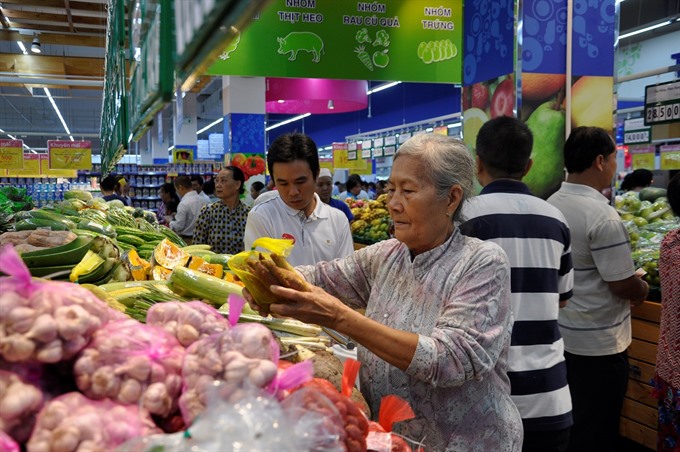 Economy
Economy

The HCM City Department of Industry and Trade met with more than 50 experts, researchers and business leaders at a meeting yesterday to discuss solutions to develop the city’s main products in the trading and services sector.
 |
| Customers shop at a supermarket in HCM City. — VNS Photo |
HCM CITY — The HCM City Department of Industry and Trade met with more than 50 experts, researchers and business leaders at a meeting yesterday to discuss solutions to develop the city’s main products in the trading and services sector.
Speaking at the meeting, Nguyễn Phương Đông, the department’s deputy director, said the sector had the highest growth rate among the city’s economic sectors for a number of years.
In 2016, the sector contributed 63.2 per cent to the city’s gross regional domestic product (GRDP).
Under the city’s plan, modern trade channels will account for at least 40 per cent of the city’s total retail sales by 2020 and 20 per cent by 2025, compared to 25 per cent now.
This will require great effort from enterprises and city authorities to expand the scale of goods exchange and meet demand of residents in their choice of shopping channels.
“The city plans to develop a list of key products in the trade and services sector and identify the most suitable support policies to exploit potential and advantages, as well as meet local demand and enhance exports,” he said.
A representative of Saigon Co.op said a key product of the city’s trading and services sector is “modern trade”. Many consumers have shifted to modern trade channels and the trend will continue.
He suggested criteria for selecting enterprises with “the best developed key products”, including annual revenue, profit-to-sales ratio, distribution networks, the number of customers a year, number of labourers, diversification of business models, amenities for customers, application of 4.0 technology, brand ranking, and others.
He said the city should help local retailers access reasonable capital sources, untie difficulties faced by the latter in land clearance and taxes, and help them improve their competitiveness amid stiff competition with foreign players.
Nguyễn Phúc Khoa, deputy chairman of the Saigon Trading Group, said "selecting modern retail as a "key product" is necessary, and that the city should focus on developing logistics services for the retail sector.
Regarding logistics, Phạm Thị Thúy Vân, marketing deputy director of Saigon Newport Corporation, said the amount of import-export goods via Tân Cảng –Sài Gòn port system had increased by 10-12 per cent per year.
Most foreign firms use Cát Lái Port to ship goods to Việt Nam thanks to its good services and inland container depot systems along Hà Nội Highway.
However, according to the city’s plan until 2020, ports along the Sài Gòn River must be moved to the south of the city.
Saigon Port has already been moved to Hiệp Phước, while Khánh Hội and Tân Thuận ports will be moved soon.
However, there is a lack of logistics services and infrastructure connection in the south of the city, despite the existence of a zoning plan for the southern area to develop port clusters.
If the city does not improve the situation soon, the city will lose its competitiveness in this sector because Long An and Bình Dương are focusing on developing international port systems, according to Vân.
In addition, in order to develop the port system and warehouses, the city needs to allocate land to investors, because the land price has been increasing strongly in the city.
Delegates at the meeting also suggested choosing logistic services, tourism (especially tourism combined with agriculture), and medical and education services as the city’s key products in the trading and services sector. — VNS